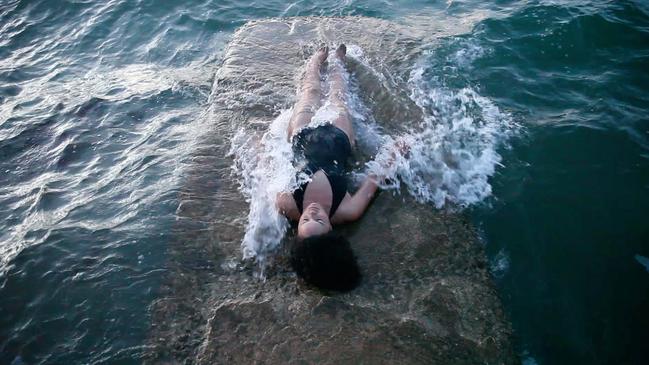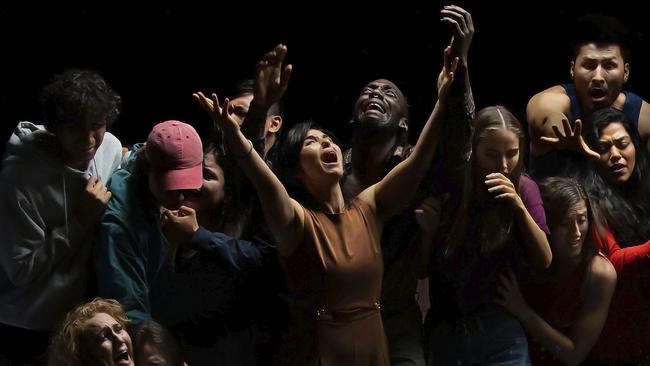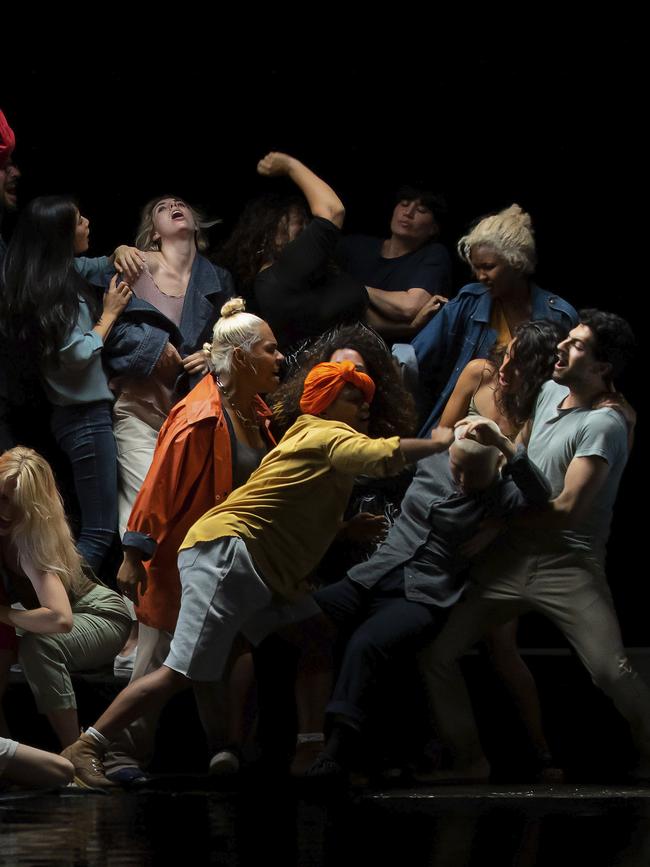Artist Angela Tiatia draws on Caravaggio for NGV installation
With her Carravaggio-inspired installation for the NGV Triennial, ‘Narcissus’, artist Angela Tiatia explores an ‘intense’ relationship with social media.

Artist Angela Tiatia often casts herself in her own works – whether it be sneaker-clad and staring intently in her 2018 Archibald Prize self-portrait, or 2014’s Heels, in which she appeared in black pumps and a Beyoncé-like bodysuit, engaging in the taboo act of exposing a tattoo on her upper thigh. But it’s not without reason.
“Being a woman of colour, historically it’s been other people that have spoken about our experience, or on our behalf,” Tiatia tells Vogue. Women have long been passive subjects in art, seen historically through the male gaze, and Tiatia’s work has explored how women of colour face the additional challenge of being seen as the “exotic other”. But, she says: “We’re grappling with change at the moment.”
“Women of colour across the world are now making works that are in stark contrast to the way they have been represented for 200 years by others,” says Tiatia. She points to an exhibition she’s a part of at Copenhagen’s Glyptotek museum, in which works by Paul Gauguin are placed alongside those by several Pacific artists, in an attempt to eschew the ways their people were at times fetishised by the painter.
For Tiatia, being able to consider the interior self and fixing on larger social concerns aren’t mutually exclusive. “For me it’s about drawing the links between the personal and the impersonal.”
While she now lives in Sydney, Tiatia was born in Auckland and has Samoan and Australian heritage, so her protean work – most often across performance, video and painting – is shaped by a diverse world view. It also has broad international appeal: along with exhibiting at Brisbane’s QAGOMA and the National Gallery of Victoria (NGV) in Melbourne, her works have been picked for the Venice Biennale, and shown in Singapore and Cuba.

When the NGV Triennial opens this month, Tiatia will show a 13-minute, large-scale video work entitled Narcissus (2019), one of 86 projects from more than 100 artists exploring themes of illumination, reflection, conservation and speculation in our strange times.
Her piece was born from what she describes as an “intense” relationship with social media. “Scrolling endlessly past selfie after selfie,” she explains, “I was falling into this mad addictive trap with social media and feeling increasingly shit about myself. Invariably you’re comparing yourself and your life to other people – even if you know their pages are highly curated and there’s a falsehood in there. You can’t help it.”
But it’s not a navel-gazing work. Quite the opposite, with Tiatia describing it as “an interrogation of the effects of intense individualism in our contemporary culture”. Though she already had a keen interest in ancient mythologies – both Pacific and European – Tiatia became fascinated by the Greek figure of Narcissus, whose transfixion with his own reflection in a shallow pool leads to his death. She says: “This myth has endured for 2,000 years because it really interrogated the crux of human nature and the forewarning of intense individualism and ego and self-love. The inability to look beyond one’s self … in the end that became Narcissus’s downfall.”
Baroque painter Caravaggio’s depiction is perhaps the most recognisable portrayal of Narcissus and the opening shot of Tiatia’s work is reminiscent of the classic painting. But in her modern take on the myth, the pool is also symbolic of the black mirror: our phones.
This time, too, instead of Narcissus as a lone figure Tiatia asked herself: ‘What would a work look like if there were 40 Narcissus, and they were all vying for a glimpse of themselves?’ Much like the chorus that would appear in a Greek tragedy, in her piece a cohort of people flail around in a fashion not dissimilar to our more odious grabs for social media attention.


“There’s this interesting duality between collective energy and stark individuality,” says Tiatia. Her work forces us to consider what is possible when, instead of each being transfixed by our own concerns, we turn our collective attention to global issues.
When Tiatia was making Narcissus she had just finished a project on the effects of climate change in Oceania. “[So] I had climate change in the back of my mind the whole time. Kind of like: ‘Come on guys! Let’s all look at this one pressing issue that affects all of us,’” she says.
Tiatia admits that even though there’s an “underlying pessimism” to Narcissus, the events of the past few months have meant the work has taken on a renewed pertinence, and moreover she feels more hopeful for humanity than she did before she set out.
“Even though this year has been really horrible, it has made a lot of us question how we live. We’re starting to be more collaborative in our lives and thinking about how important and powerful social structures are,” she says. “Even seeing how the world came together over the Black Lives Matter movement [was] promising.”
Much like the subtle gesture in the closing moments of Narcissus – which Tiatia says is there to provide “a tinge of hope” – she believes the Triennial will be a mirage of sorts, for people to “experience the world again” after a difficult year. When a sign of optimism rises from desolation, she says. “I love that moment so much.”
The NGV Triennial is on at NGV International from December 19 to April 18, 2021. For more information, go to ngv.vic.gov.au. This article appears in the November 2020 issue of Vogue Australia – on sale now.

To join the conversation, please log in. Don't have an account? Register
Join the conversation, you are commenting as Logout